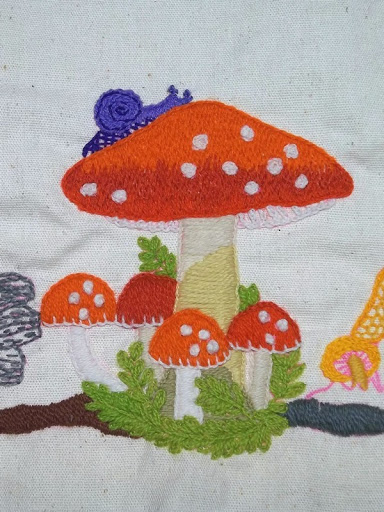 |
| Part of the crewel embroidery mushrooms in progress |
First, let me apologize for writing fewer posts this summer. The farmers' market season, which occupied so much of our time, is finished here in the high country. Although we are still very busy, harvesting, transplanting, getting gardens ready for winter and “weather-proofing” the house, greenhouse, and out-buildings, my thoughts are turning to completing unfinished projects and planning new ones. My fingers are eager to work with yarn — whether for rug-making, crocheting, knitting or embroidery. One of my first projects to finish is a rectangular crewel embroidery piece featuring fanciful mushrooms done in wool yarn on rather coarse linen. One of these motifs was featured at the end of the August 31, 2015 post.
 |
| Detail of Bayeux Tapestry from Wikimedia Commons |
One of the oldest (and largest!) pieces of crewel embroidery still in existence is the Bayeux Tapestry (not a real tapestry because it was embroidered rather than woven), probably embroidered by needlewomen of Normandy to celebrate William the Conqueror's victory over England in 1066 A.D. The piece is believed to have been completed about 1100 A.D. Besides land and sea battles, it shows many details about costumes, artifacts, techniques and customs of the time.
Crewel embroidery became popular in England during the reign of Queen Elizabeth I. The queen loved roses and native wildflowers, so these motifs were widely used, along with leaves and vines like those on the 20th-century European handbag shown here. One of the major functions of this type of embroidery was to provide warmth. The embroidery added weight and thickness to bed curtains and canopies, draperies, and wall coverings made of linen or wool. The work was usually done by groups of needleworkers, supervised by an experienced embroiderer, who may also have designed the motifs. Lovely examples of this work are exhibited at the Victoria and Albert Museum in London.
Crewel embroidery reached the peak of its popularity during the reign of Queen Elizabeth I's successor, King James I. Work from this period is also called Jacobean embroidery. The designs were heavily influenced by the Chinese and other Oriental fabrics, porcelains, and lacquer-work which were beginning to be imported into England at that time. This Jacobean influence can still be discerned in much more modern crewel embroidery like that on the 20th-century European pillow cover shown here. Dragons, gryphons, and other mythical creatures were also popular in the 17th century.
The word “crewel” refers to the type of yarn they used, a loosely twisted 2-ply (2-strand) wool yarn. I prefer Paternayan® crewel yarn and a 3-ply Persian yarn (used for the mushrooms) that I separate as needed. Unfortunately, these have become more expensive and harder to find in recent years. We have talked previously about dividing 3-ply and 4-ply yarns (May 29, 2015 post). You will find some of these synthetic yarns easier to embroider with than others. Practice with them to make your choices. You can also use novelty yarns and silk, linen, cotton and rayon flosses. You just can't call your work crewel embroidery unless it is done with wool yarn. (I recommend calling it “crewel-style” embroidery.)
Early colonists brought crewel patterns and techniques to the New World, where they became quite popular. We have already discussed several of the stitches widely used in crewel embroidery, such as cross-stitch, back-stitch, running stitch and double-running stitch. (If you are new to this blog, check our search feature.) We've also shown techniques such as whipping, lacing, interlacing, etc., which embellish these simple stitches. You may want to review some of these on the January 16, 2015 post before we begin a crewel project. (Use our Archive to find it.) You can see some of these techniques used on the completed mushroom motifs.
I made separate hot-iron transfers for each section of the mushroom design. (See the post for October 6, 2013.) You can see what the transfer looks like on this unfinished motif. Some red lines from the transfers will show around the finished embroidery. To remove them, I will gently hand-wash the embroidery in cool water and Woolite®, rubbing until the red lines disappear. A quick rinse and the entire piece will be ready to be pressed or blocked. I'm looking forward to our first crewel project together. I hope you are too.
See you again soon,





No comments :
Post a Comment
Post a New Comment Below -- We Love Feedback !!!